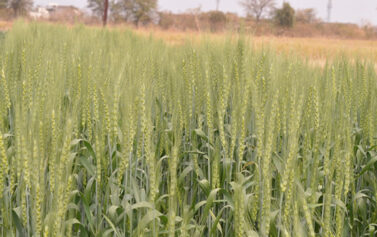Wheat

India is the world’s second largest wheat grower after China. Wheat is the main cereal crop in India. The total area under the crop is about 29.8 million hectares in the country. Various studies and researches show that wheat and wheat flour play an increasingly important role in the management of India’s food economy.
Indian wheat is largely a soft/medium hard, medium protein, white bread wheat, somewhat similar to U.S. hard white wheat. Wheat grown in central and western India is typically hard, with high protein and high gluten content. India also produces around 1.0-1.2 million tons of durum wheat, mostly in the state of Madhya Pradesh. Most Indian durum is not marketed separately due to segregation problems in the market yards. However, some quantities are purchased by the private trade at a price premium, mainly for processing of higher value/branded products.
Climatic Requirement
Wheat crop has wide adaptability. It can be grown not only in the tropical and sub-tropical zones, but also in the temperate zone and the cold tracts of the far north,beyond even the 60 degree north altitude. Wheat can tolerate severe cold and snow and resume growth with the setting in of warm weather in spring. It can be cultivated from sea level to as high as 3300 meters. The best wheat are produced in areas favoured with cool, moist weather during the major portion of the growing period followed by dry, warm weather to enable the grain to ripen properly. The optimum temperature range for ideal germination of wheat seed is 20-25c though the seeds can germinate in the temperature range 3.5 to 35c. Rains just after sowing hamper germination and encourage seedling blight. Areas with a warm and damp climate are not suited for wheat growing.
Soil
Wheat is grown in a variety of soils of India. Soils with a clay loam or loam texture, good structure and moderate water holding capacity are ideal for wheat cultivation. Care should be taken to avoid very porous and excessively drained oils. Soil should be neutral in its reaction. Heavy soil with good drainage are suitable for wheat cultivation under dry conditions. These soils absorb and retain rain water well. Heavy soils with poor structure and poor drainage are not suitable as wheat is sensitive to water logging. Wheat can be successfully grown on lighter soils provided their water and nutrient holding capacity are improved.
Varieties
The main varieties of wheat grown in India are VL-832,VL-804, HS-365, HS-240 , HD2687,WH-147, WH-542, PBW-343, WH-896(d), PDW-233(d), UP-2338, PBW-502, Shresth (HD 2687), Aditya (HD 2781), HW-2044, HW-1085, NP-200(di), HW-741.
Major Wheat Growing States
Uttar Pradesh, Punjab, Haryana, Madhya Pradesh, Rajasthan, Bihar and Gujarat.
Wheat – All India Area and Production
|
|
2017-18 |
2018-19 | 2019-20 | 2020-21 | 2021-22 | 2022-23 |
| Area (Million Hectares) |
29.7 | 29.3 | 31.4 | 31.1 | 30.5 | 31.9 |
| Production (Million Tonnes) |
99.8 | 103.6 | 107.9 | 109.6 | 107.7 | 110.6 |
Source:Directorate of Economics & Statistics, Department of Agriculture and Farmers Welfare.
2nd Advance Estimates of Production of Food Grains for 2023-24
Wheat Exports
Today, India is exporting sufficient quantities of all types of wheat and extensive research efforts are underway for improving its cereals and grain output in the years to come. World trade in wheat is greater than for all other crops combined. Demand of India’s wheat in the world shows a rising trend. The country has exported 46,93,264.09 MT of wheat to the world for the worth of around Rs.11,827 crores during the year of 2022-23.
Wheat Exports From India
|
|
2019-20 |
2020-21 | 2021-22 |
2022-23 |
2023-24* |
|
Value |
443.16 | 4,162.13 | 15,768.85 | 11,685.24 | 358.32 |
*2023-2024 (April – January)
Source:Department of Commerce, Ministry of Commerce and Industry, Govt. of India
https://tradestat.commerce.gov.in
References:
- Farmers’ Portal (https://farmer.gov.in)
- Agricultural and Processed Food Products Export Development Authority (http://apeda.gov.in)
